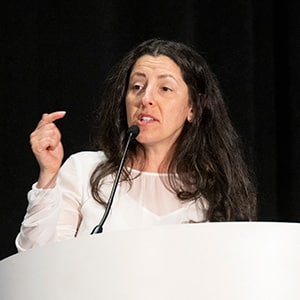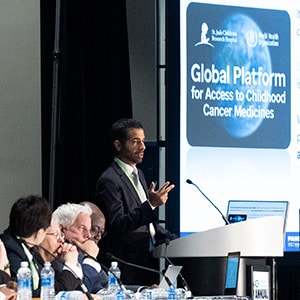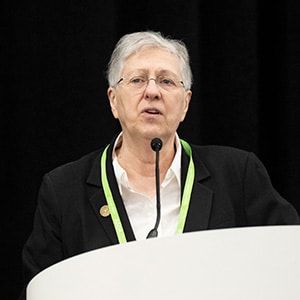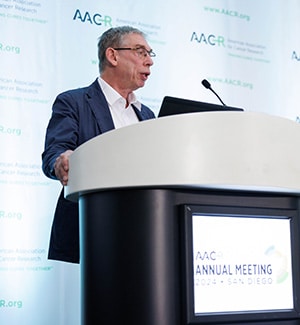About 1 in 5 people currently develop cancer in their lifetime. By 2050, the global incidence of cancer is expected to increase from 20 million cases each year to over 35 million. These projections are one of the reasons Patricia M. LoRusso, DO, PhD(h), FAACR, made global health a key initiative of her tenure as President of the American Association for Cancer Research (AACR).

“Cancer is a global disease—it spares no continent, no country,” LoRusso, of Yale University, said during the meeting. “And each patient that gets the disease deserves treatment.”
In one of her final acts as AACR President, LoRusso chose to showcase the impact of cancer research around the world during the Presidential Select Symposium at the AACR Annual Meeting 2025, held April 25-30.
The session, “Leveraging Science to Reduce the Cancer Burden Worldwide,” invited a panel of speakers who shared shining examples of work that is making a difference in various countries.
Costa Rica: One Dose of HPV Vaccination Can Protect Against Cervical Cancer
Aimée R. Kreimer, PhD, of the National Cancer Institute (NCI), revealed recently unblinded results from a 20-year study that caused attendees to applaud in excitement. The ESCUDDO trial enrolled 20,330 girls between ages 12 and 16 in Costa Rica to evaluate the noninferiority and efficacy of one versus two doses of HPV vaccination. The girls were randomly assigned to receive either Cervarix or Gardasil 9 and then randomly assigned again to receive either one or two doses. For both vaccines, one dose was no less effective than two doses in protecting against HPV16/18 infection, with either dosage resulting in at least 97% vaccine efficacy. Long-lasting infection of HPV16/18 is a known cause of cervical cancer, as well as anal, oropharyngeal, penile, vaginal, and vulvar cancers.

In 2022, the World Health Organization (WHO) issued an alternative, off-label recommendation for a single-dose schedule of the HPV vaccine in females between the ages of 9 and 20 based on earlier observational studies that also found similar efficacy between one and two doses. As of April 2025, 68 countries recommend single-dose HPV vaccination, but Kreimer said that these trial results could lead more countries to implement HPV vaccination.
“A lot of countries with very large birth cohorts of girls still have yet to introduce HPV vaccination,” she explained. “A global single-dose HPV recommendation should facilitate country introductions and vaccine uptake. With single-dose vaccination and simplified screening, that is truly the pathway to accelerated cervical cancer control globally.”
Malaysia: Using Phones to Screen for Oral Cancer
Oral cancer can be easy to detect, if you have access to a specialist capable of performing an exam, explained Sok Ching Cheong, PhD, of Cancer Research Malaysia. Unfortunately, that is not always the case for those in low- and middle-income countries where the mortality rate from oral cancer is nearly four times higher than in high-income countries. Incidence of oral cancer is also highest in Asia, where about two-thirds of worldwide cases are diagnosed.
To help diagnose oral cancer earlier in rural areas of Malaysia, Cheong and her colleagues developed MeMoSA, a mobile health tool in which volunteers can screen individuals through a teleconsultation with a specialist using their phones. In a pilot study for MeMoSA that was conducted with Malaysia’s Ministry of Health, Cheong said they were able to increase screening tenfold. Cheong and her colleagues are currently working with seven other countries on programs involving MeMoSA, including Sri Lanka where oral cancer is the most prevalent cancer among males.
In the longer term, Cheong said that geotagged data could help identify areas most in need of follow-up screenings due to high prevalence of risk factors such as smoking. Additionally, the images collected could eventually help train artificial intelligence (AI) to be used as a diagnostic tool; however, Cheong stressed that not all innovative ideas require novel technology.
“There are many screening strategies right now that work, but they’re not getting to the right people,” Cheong explained. “We need to innovate the way we deliver these screening methods.”
Kenya: Taking Endoscopies to the People
Endoscopy is an example of a screening method that is known to work, but one that isn’t easily accessible to many people in Kenya. Robert Bristow, MD, PhD, of the University of Manchester and one of the session’s moderators, explained that esophageal squamous cell carcinoma is the third most common cancer in Kenya with a fatality rate of 99.3%—compared to about 55% in the United Kingdom. Part of the reason for this is about 75% of Kenyans live in rural areas while about 80% of cancer treatment centers are in the country’s largest city of Nairobi.
Bristow partnered with F. George Njoroge, PhD, of Kenyatta University Teaching, Referral, and Research Hospital, on a program that developed mobile endoscopy suites capable of traveling to remote counties in Kenya. In addition to providing the tools for screening, Njoroge expressed the importance of increasing awareness about the risks of esophageal cancer, what screening entailed, and how the information being collected could help individuals.
“Engagement with the community is so important because with that engagement there’s more acceptance and the community becomes part of our advocacy group,” Njoroge, also one of the session’s panelists, explained.

South Africa: Reaching Out to Remote Areas
Vanessa M. Hayes, PhD, who is at the University of Sydney but was born, educated, and continues to run a lab in South Africa, added that engagement can’t be one and done and it requires long-term immersion to build trust. For example, her group has worked to increase prostate cancer awareness and screening because many men from the poorest regions in and around South Africa are unaware they even have a prostate and are unable to travel to health clinics to undergo screening. So, Hayes and her colleagues have spent the last decade engaging with local tribal healers to educate them about prostate cancer and screening methods.
In another example, she mentioned how one physician started a health care company with the help of Microsoft. They designed a backpack with solar panels that served as a basic triage kit with portable blood and urine tests, pulse oximeters, blood pressure monitors, and other diagnostic tools. In this arrangement, health care workers upload the data from the diagnostic devices and a patient questionnaire to an app that provides care recommendations. In instances when patients require more intensive treatment, Microsoft sends doctors to those regions or connects the on-site health care workers with specialists remotely. In the future, Hayes would like to find a way to incorporate screening for prostate cancer into the services they provide.
Malawi: Building Diagnostic Infrastructure
Prior to joining the NCI, Satish Gopal, MD, MPH, spent a decade living in low-income countries in Africa, including Malawi, where he served as the only medical oncologist.
“The lack of infrastructure is probably the most frequently cited reason why researchers don’t want to engage with collaborators in low- and middle-income countries, but that problem is actually quite easily overcome and frequently overstated,” he said of his experience there.

With only a modest investment of time and money, he helped upgrade the diagnostic infrastructure in the country and established weekly teleconference meetings with pathologists in the United States to review cases, a practice that continues to this day. These improvements are leading to new understandings about cancer in these understudied populations, including how the tumor biology of patients with diffuse large B-cell lymphoma (DLBCL) may differ depending on their HIV status and whether they have been treated with antiretroviral therapy. This has also opened new opportunities to test established therapeutics in places where fewer clinical trials have been conducted, including several ongoing trials in Africa looking at different immunotherapies for various forms of lymphoma.
“Patients in Africa will be younger, [with] less treatment experience, different histologic distribution, different microbiomes, different early childhood infection exposure, and [different] immune priming, all of which might suggest that immunotherapy might perform differently for this population,” Gopal explained. He added that it is important to consider how the information we have from many completed oncology clinical trials might not apply to people in other parts of the world.
India: Using AI for Clinical Support
Another area where a lack of information about different populations may cause bias is in the development of AI tools. C.S. Pramesh, MD, of Tata Memorial Hospital, said that when the right amount of data from different groups is fed into AI, it can be a game-changer.
For instance, he mentioned in India they need 2.6 times more oncologists than they currently have to meet demand in the country. To help alleviate this burden, Pramesh and his colleagues developed an AI platform where patients can upload any medical reports they have, such as handwritten notes from physicians, CT or MRI scans, pathology images, etc. The platform then converts the multiformat files into structured data for an expert within India’s National Cancer Grid to review. Within 24 hours, feedback from the expert is sent back to the patient. While this clinical decision support system was initially created to serve low- and middle-income countries, 23 out of the 58 countries that have already linked into the platform have been high-income countries.
“This is not a problem just limited to low- and middle-income countries,” Pramesh said. “Given the challenges of access that we currently have, not using such tools would be foolish.”
Reaching a Global Consensus Around Cancer
One of the reasons LoRusso assembled this panel is because of her assertion that the work being done in one country can inform others, ultimately benefiting everyone.
“We need to be universal in our mission, our message, and our approach,” LoRusso said.

André Ilbawi, MD, of WHO, echoed this vision. He noted that all countries, no matter their research capacity, must align on a global agenda in order to make progress in reducing cancer incidence around the world. He pointed to previous consensus on reducing the HIV epidemic and controlling tobacco as examples that led to global progress in those areas. For cancer, he suggested the need for alignment around the technologies for diagnosis, endpoints for clinical trials, templates for databases everyone can access, and research priorities.
“We [need] country-comparable estimates and benchmarks to advance progress,” Ilbawi said.
LoRusso is already putting her words into action. In March, she traveled to Kenya with AACR staff and launched the first phase of a new initiative to develop educational opportunities within African institutions, which will support the creation of a sustainable clinical cancer research workforce. During her Presidential Address at the AACR Annual Meeting 2025, she also discussed what is needed to achieve personalized cancer medicine that can benefit all patients. She mentioned several areas of research that must advance further for this to happen, including ones she is exploring in her own work, such as epigenetics and spatial biology.
“The global cancer burden is horrific,” she said. “We need to define a hierarchical knowledge so that we can truly personalize medicine and hopefully not only treat patients with cancer but … advance prevention and interception as well.”
The post Presidential Symposium Showcases Global Researchers Tackling Cancer Burden appeared first on American Association for Cancer Research (AACR).



